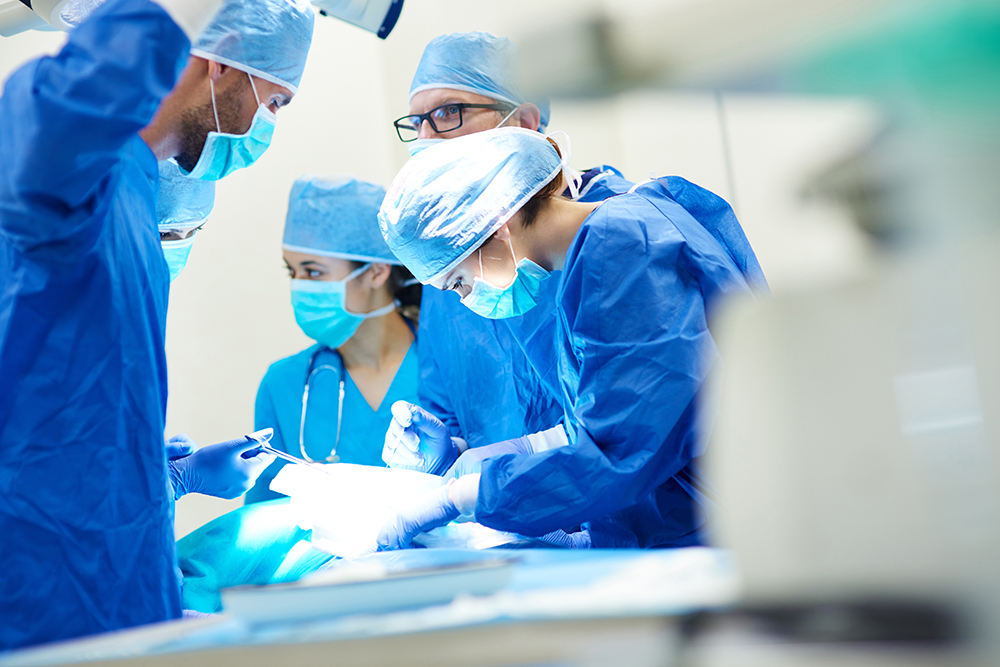Revision Knee Replacement
Total knee replacement is one of the most successful procedures in all of medicine. In the vast majority of cases, it enables people to live richer, more active lives free of chronic knee pain. Over time, however, a knee replacement may fail for a variety of reasons. When this occurs, your knee can become painful and swollen. It may also feel stiff or unstable, making it difficult to perform your everyday activities.
If your knee replacement fails, your doctor may recommend that you have a second surgery—revision total knee replacement. In this procedure, your doctor removes some or all of the parts of the original prosthesis and replaces them with new ones.
Although both procedures have the same goal—to relieve pain and improve function—revision surgery is different than primary total knee replacement. It is a longer, more complex procedure that requires extensive planning, and specialised implants and tools to achieve a good result.
During primary total knee replacement, the knee joint is replaced with an implant, or prosthesis, made of metal and plastic components. Although most total knee replacements are very successful, over time problems such as implant wear and loosening may require a revision procedure to replace the original components.
There are different types of revision surgery. In some cases, only one implant or component of the prosthesis has to be revised. Other times, all three components—femoral, tibial, and patellar—need to removed or replaced and the bone around the knee needs to be rebuilt with augments (metal pieces that substitute for missing bone) or bone graft.
Damage to the bone may make it difficult for the doctor to use standard total knee implants for revision knee replacement. In most cases, he or she will use specialized implants with longer, thicker stems that fit deeper inside the bone for extra support.
When Revision Total Knee Replacement Is Recommended
In order for a total knee replacement to function properly, an implant must remain firmly attached to the bone. During the initial surgery, it was either cemented into position or bone was expected to grow into the surface of the implant. In either case, the implant was firmly fixed. Over time, however, an implant may loosen from the underlying bone, causing the knee to become painful.
The cause of loosening is not always clear, but high-impact activities, excessive body weight, and wear of the plastic spacer between the two metal components of the implant are all factors that may contribute. Also, patients who are younger when they undergo the initial knee replacement may “outlive” the life expectancy of their artificial knee. For these patients, there is a higher long-term risk that revision surgery will be needed due to loosening or wear.
In some cases, tiny particles that wear off the plastic spacer accumulate around the joint and are attacked by the body’s immune system. This immune response also attacks the healthy bone around the implant, leading to a condition called osteolysis. In osteolysis, the bone around the implant deteriorates, making the implant loose or unstable.
Infection is a potential complication in any surgical procedure, including total knee replacement. Infection may occur while you are in the hospital or after you go home. It may even occur years later. If an artificial joint becomes infected, it may become stiff and painful. The implant may begin to lose its attachment to the bone. Even if the implant remains properly fixed to the bone, pain, swelling, and drainage from the infection may make revision surgery necessary. Revision for infection can be done in one of two ways, depending on the type of bacteria, how long the infection has been present, the degree of infection, and patient preferences.
• Debridement. In some cases, the bacteria can be washed out, the plastic spacer can be exchanged, and the metal implants can be left in place.
• Staged surgery. In other cases, the implant must be completely removed. If the implant is removed to treat the infection, your doctor will perform the revision in two separate surgeries. In the first surgery, he or she will remove the implant and place a temporary cement spacer in your knee. This spacer is treated with antibiotics to fight the infection and will remain in your knee for several weeks. During this time, you will also receive intravenous antibiotics. When the infection has been cleared, your doctor will perform a second surgery to remove the antibiotic spacer and insert a new prosthesis. In general, removing the implant leads to a higher chance of curing the infection, but is associated with a longer recovery.
If the ligaments around your knee become damaged or improperly balanced, your knee may become unstable. Because most implants are designed to work with the patient’s existing ligaments, any changes in those ligaments may prevent an implant from working properly. You may experience recurrent swelling and the sense that your knee is “giving way.” If knee instability cannot be treated through nonsurgical means such as bracing and physical therapy, revision surgery may be needed.
Sometimes a total knee replacement may not help you achieve the range of motion that is needed to perform everyday activities. This may happen if excessive scar tissue has built up around the knee joint. If this occurs, your doctor may attempt “manipulation under anesthesia.”
In this procedure, you are given anesthesia so that you do not feel pain. The doctor then aggressively bends your knee in an attempt to break down the scar tissue. In most cases, this procedure is successful in improving range of motion. Sometimes, however, the knee remains stiff. If extensive scar tissue or the position of the components in your knee is limiting your range of motion, revision surgery may be needed.
A periprosthetic fracture is a broken bone that occurs around the components of a total knee replacement. These fractures are most often the result of a fall, and usually require revision surgery.
In determining the extent of the revision needed, your doctor will consider several factors, including the quality of the remaining bone, the type and location of the fracture, and whether the implant is loose. When the bone is shattered or weakened from osteoporosis, the damaged section of bone may need to be completely replaced with a larger revision component.
For more information on revision knee replacement please do not hesitate to get in touch with Mr Atwal through our appointments page.


QUICK ENQUIRY
Recent Patient Videos
1 year post Unilateral Replacement
1 year post Total Replacement
1 year post Total Replacement
6 months post Unilateral Replacement


